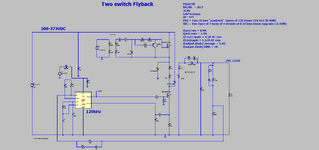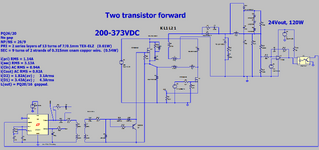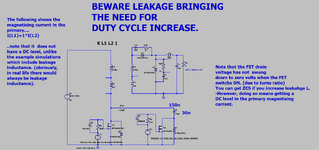cupoftea
Advanced Member level 5
Hi,
Do you agree the Two Transistor Forward ("2TFor") is preferable over the Two Transistor Flyback ("2TFly") for the following spec SMPS..
Vin = 200-373VDC
Vout = 24V
W(out) = 125W
The attached shows PNGs and LTspice's of the two converters for comparison.
The 2TFor is preferrable because ....
1...It does not need a gapped core transformer. (always difficult to find in stock)
(It does need a gapped output inductor core, but thats an easy part to do a multi-footprint
for, so that you dont suffer nil-stocks)
2...Less Secondary RMS current in the transformer.
3...Two output diodes, but thats good because they share the dissipation between them. Unlike
the flyback where one diode takes all the dissipation.
4....Less ripple requirement for output caps (4.5 times less).
5...If Vin suddenly falls below Vout* NP/NS then it wont blow up.
Do you agree the Two Transistor Forward ("2TFor") is preferable over the Two Transistor Flyback ("2TFly") for the following spec SMPS..
Vin = 200-373VDC
Vout = 24V
W(out) = 125W
The attached shows PNGs and LTspice's of the two converters for comparison.
The 2TFor is preferrable because ....
1...It does not need a gapped core transformer. (always difficult to find in stock)
(It does need a gapped output inductor core, but thats an easy part to do a multi-footprint
for, so that you dont suffer nil-stocks)
2...Less Secondary RMS current in the transformer.
3...Two output diodes, but thats good because they share the dissipation between them. Unlike
the flyback where one diode takes all the dissipation.
4....Less ripple requirement for output caps (4.5 times less).
5...If Vin suddenly falls below Vout* NP/NS then it wont blow up.


